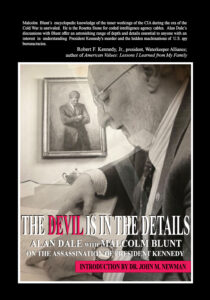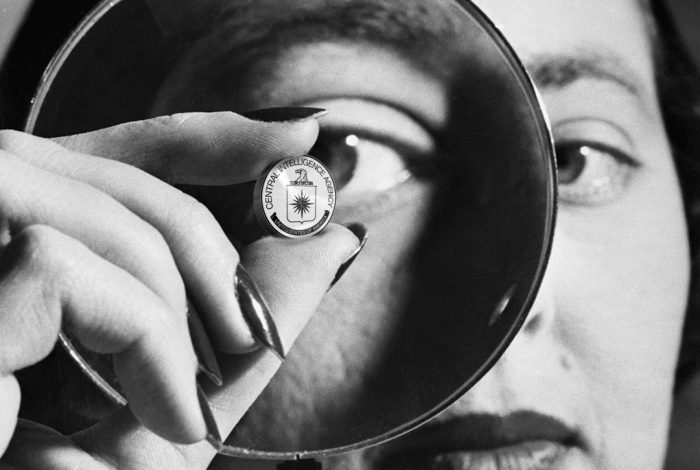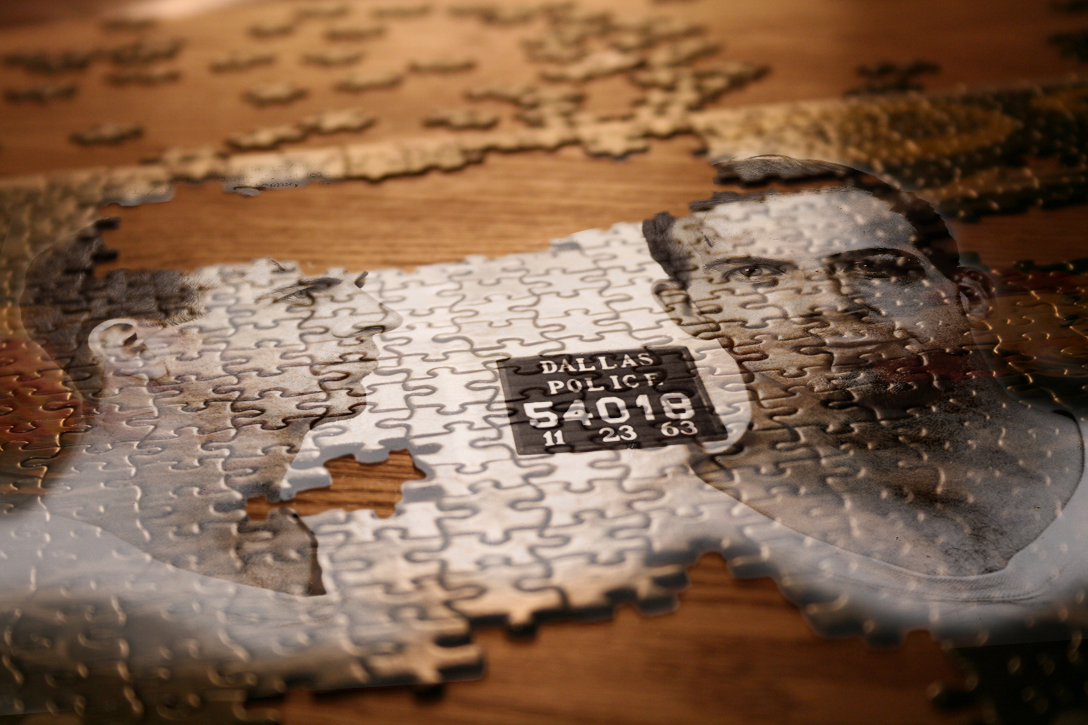Prescient, you say? Uh-huh.
 Following is from my Malcolm Blunt book, The Devil is in the Details, Chapter Seven, Quilted Patterns, published November 2020. The conversation took place in late November of 2016:
Following is from my Malcolm Blunt book, The Devil is in the Details, Chapter Seven, Quilted Patterns, published November 2020. The conversation took place in late November of 2016:Transcript by Mary Constantine.
 Following is from my Malcolm Blunt book, The Devil is in the Details, Chapter Seven, Quilted Patterns, published November 2020. The conversation took place in late November of 2016:
Following is from my Malcolm Blunt book, The Devil is in the Details, Chapter Seven, Quilted Patterns, published November 2020. The conversation took place in late November of 2016:Transcript by Mary Constantine.
20 March, 2021|Courtesy of Rex Bradford:
This essay discusses the state of the JFK Records Collection as of March 2021. It describes the background and results of the declassifications which occurred in 2017 and 2018, and alerts readers to the re-review which is taking place this year. Particular focus is placed on 3,598 “withheld in full” records which the National Archives and Records Administration (NARA) declared would be finally released. Some were, and some weren’t, as will be explained.
A companion page, 2017 Document Releases, discusses the set of records that were released in 2017 and 2018, along with links to read and search them all.
Another companion page, Withheld in Full – 2021 Update, contains an interactive table where the not-released portion of the 3,598 “withheld in full” records may be explored.
Following public outcry over Oliver Stone’s film JFK, Congress in 1992 passed the JFK Records Act. This law created the Assassination Records Review Board (ARRB), which from 1994 until 1998 oversaw the declassification of a large number of documents related to the assassination of President Kennedy and the various investigations into his murder; this broad effort included a wide swath of formerly-secret records on Kennedy foreign policy on Cuba and Vietnam, and FBI and CIA and other agencies’ files on myriad related topics and individuals.
The revelations from the declassifications of the 1990s have rewritten the story of the formation of the Warren Commission, thrust into prominence Lee Harvey Oswald’s trip to Mexico City in the fall of 1963 and the allegations of Communist conspiracy emanating from that city, and turned that story on its head with the stunning news that Director Hoover – in a memo to the Secret Service and a now-erased presidential phone call – relayed the FBI’s determination that someone had impersonated Oswald there. Also released were formerly-secret notes of Oswald’s interrogation which include an alibi for his whereabouts, buried testimony about the nature of JFK’s wounds (and thus the direction of shots) which was taken by Congressional investigators and then hidden, documents revealing that CIA officers lied about their knowledge of Oswald before the assassination, a Pentagon false-flag operation named Northwoods outlining terrorist acts which could be implemented and then used to justify a U.S. invasion of Cuba, written plans kept secret for 35 years to withdraw U.S. forces from Vietnam, and so much more, far too voluminous to even summarize here.
The JFK Records Act has been in many ways a great success in reaching toward a fuller history of Kennedy’s murder and its context.
The JFK Collection now sits at over 300,000 records comprising over 5 million pages, plus abundant photographic and audiovisual records. The records processed in the 1990s and later all have a unique 13-digit record number assigned to them and are represented in a master collection database. A substantial portion of the 5 million pages, including voluminous Warren Commission files, predate this system, have no record numbers, and do not appear in the database.
But while the ARRB oversaw a massive declassification effort, it also deferred in many cases to government agencies desiring continued secrecy; tens of thousands of JFK records were released with “redactions” (blackouts) – sometimes as small as a name, sometimes entire pages. And thousands of records remained “withheld in full.”
The JFK Records Act mandated that, 25 years after the passage of the Act, all such records should be released in full, barring a determination by the president that “continued postponement is made necessary by an identifable harm to the military defense, intelligence operations, law enforcement, or conduct of foreign relations” and “the identifiable harm is of such gravity that it outweighs the public interest in disclosure.”
The 25-year deadline came on October 26, 2017. But when the 25-year deadline finally arrived, the remaining records were not released in full. Instead, under a process approved by then-President Trump:
It is now 2021.
 John Judge (1948 – 2014) was a respected researcher, writer, public speaker, and community organizer. He was a co-founder of the Coalition on Political Assassinations (COPA), and organized COPA’s annual JFK conference held each year in Dallas, Texas. Judge was an early advocate for the creation of the Assassination Records Review Board. He continued to campaign for the de-classification and full-disclosure of Kennedy and King assassination records still being withheld by the U.S. federal government.
John Judge (1948 – 2014) was a respected researcher, writer, public speaker, and community organizer. He was a co-founder of the Coalition on Political Assassinations (COPA), and organized COPA’s annual JFK conference held each year in Dallas, Texas. Judge was an early advocate for the creation of the Assassination Records Review Board. He continued to campaign for the de-classification and full-disclosure of Kennedy and King assassination records still being withheld by the U.S. federal government.
Dated 25 April, 1996, following is Judge’s 6-page letter to Jeremy Gunn who served on the Assassination Records Review Board (ARRB) staff as Chief of Research and Analysis, General Counsel, and was eventually appointed as Executive Director. Click on page to enlarge.
Judge for Yourself: A Treasury of Writing by John Judge – April 13, 2017 may be purchased at Amazon. Click HERE.

Bill Simpich is a civil rights attorney in the San Francisco Bay Area. He is on the board of directors of the Mary Ferrell Foundation, an organization focused on the study of documents related to the 1960s assassinations, Watergate, and Iran-Contra.
In the following essay, he offers a look at some of the gems found in the new JFK document releases and how to speed up the discovery of future finds.
More than 50 years after the assassination of President John F. Kennedy, thousands of government documents related to his death are still under classified lock and key.
By law, all of the remaining secret documents were supposed to have been released last year. President Donald Trump approved the release of approximately 35,000 files in 2017. But he delayed the publication of many other documents in full or in part until 2021 — when the winner of the 2020 presidential election will have another chance to review them for possible declassification.
Researchers have been digging through the released documents in search of a “smoking gun” file which neatly explains to skeptics what really happened that dark day in Dallas. While it’s possible such a document exists, it’s unlikely.
The difficult job of understanding why a president was murdered, and unpacking the Cold War path that America was treading, involves working through the minutiae — the “boring” material — so that the little puzzle pieces can fit together to form a coherent bigger picture.
One year ago this week, the National Archives and Records Administration released the first of what were to be seven batches of newly declassified documents. Some of those documents had actually been released in past decades, albeit with extensive redactions. Others had never been seen before.
Analysis of the newly available documents, including those released in the 1990s — most of which still remain undigitized — are already shedding light on the murky background of President Kennedy’s murder.
Among other things, the findings offer a golden opportunity to unpack more of the hidden history of the Cold War, revise our assumptions about that fraught era, and — finally — get the story right.
There will be no new document releases until 2021. That gives us three years to digest what we already have, and to create some stronger tools for analysis.
But the work of researchers and interested citizens is already paying off.
Take the ongoing research on cryptonyms, or crypts — government codewords for people, places, and things that the intelligence community meant to keep hidden.
As someone who has spent a lot of time solving CIA cryptonyms for the Mary Ferrell Foundation (MFF) website, one of the premier online digital archives of JFK documents, let me say a brief word on why decoding the cryptonyms is important. When you know the names of the CIA programs, officers, and agents whose names are hidden, a whole new way of seeing the world opens up to you.
Cryptonyms usually begin with a two-letter prefix that identifies the country of origin (e.g., “AM” for Cuba or “LI” for Mexico), and then the remainder of the word reveals the program (e.g., AMCANOE refers to a project to unify exiles, many of whom had traveled by water from Cuba into the US).
It becomes particularly important when you see memos like this, saying that “we cannot give wholesale approval for their release [cryptonyms], but if the crypts have been previously blown or exposed they can be released.”

The JFK case is a jigsaw puzzle the size of a football field. Photo credit: Adapted by WhoWhatWhy from Jolene Faber / Flickr (CC BY 2.0) and ARCHIVES.GOV.
Many new crypts have been revealed in the new release. Just two of the recent examples:
CONTINUE READING at WhoWhatWhy
Rex Bradford, President, Mary Ferrell Foundation June 18, 2018
SUMMARY
Under the President John F. Kennedy Records Collection Act of 1992 (“JFK Records Act”), the Assassination Records Review Board (“ARRB”) oversaw the declassification of millions of pages of formerly classified records. But a significant number of documents were withheld in full, and many more were withheld with “redactions” (portions withheld from view).
As noted in the ARRB’s Final Report, the JFK Records Act included a provision for full release 25 years after its passage. Specifically, it “mandated that all postponed assassination records be opened to the public no later than the year 2017” unless the President certifies that (1) “continued postponement is made necessary by an identifiable harm to the military, defense, intelligence operations, law enforcement, or conduct of foreign relations” and (2) “the identifiable harm is of such gravity that it outweighs the public interest in disclosure.” (https://www.maryferrell.org/showDoc.html?docId=3611#relPageId=33).
Instead of full disclosure, what occurred was a rolling set of partial releases, 7 so far, along with continued withholding. On the positive side, for the first time the National Archives and Records Administration (NARA) published the newly released documents online in PDF format, a huge boon to researchers. But this process has been marred by errors and confusion, as documented herein.
Currently according to NARA, 15,834 documents remain withheld in part, along with a smaller set still withheld in full. Both the current state of affairs, and the process by which releases have occurred, are less than satisfactory.
This paper documents the recent history of releases and the numerous problems with the process and the current state of affairs. It does not discuss the question of “what’s in the new records?” – suffice to say that there are important documents being uncovered, related to the assassination investigations and also the context of Kennedy Cold War policies, and that the full “digestion” process will take time.
RELEASE HISTORY
After an early release of records in July of 2017, the 25-year anniversary arrived on October 26. Against a backdrop of lobbying by federal agencies, President Trump
signed an authorization for continued withholding of most of the remaining records, release of some, and an accompanying review process with a 6-month deadline.
In November and December of 2017, 4 additional releases happened. When the 6month review deadline came on April 26, 2018, a seventh release occurred, along with continued withholding and a new review deadline set for 2020.
In all, tens of thousands of documents were released or re-released, though over 15,000 documents remain withheld at least in part.
Continue reading: DOWNLOAD THE ENTIRE ARTICLE
